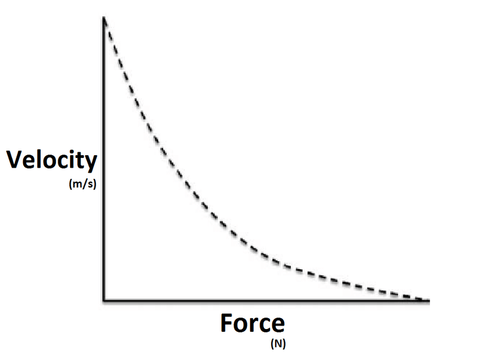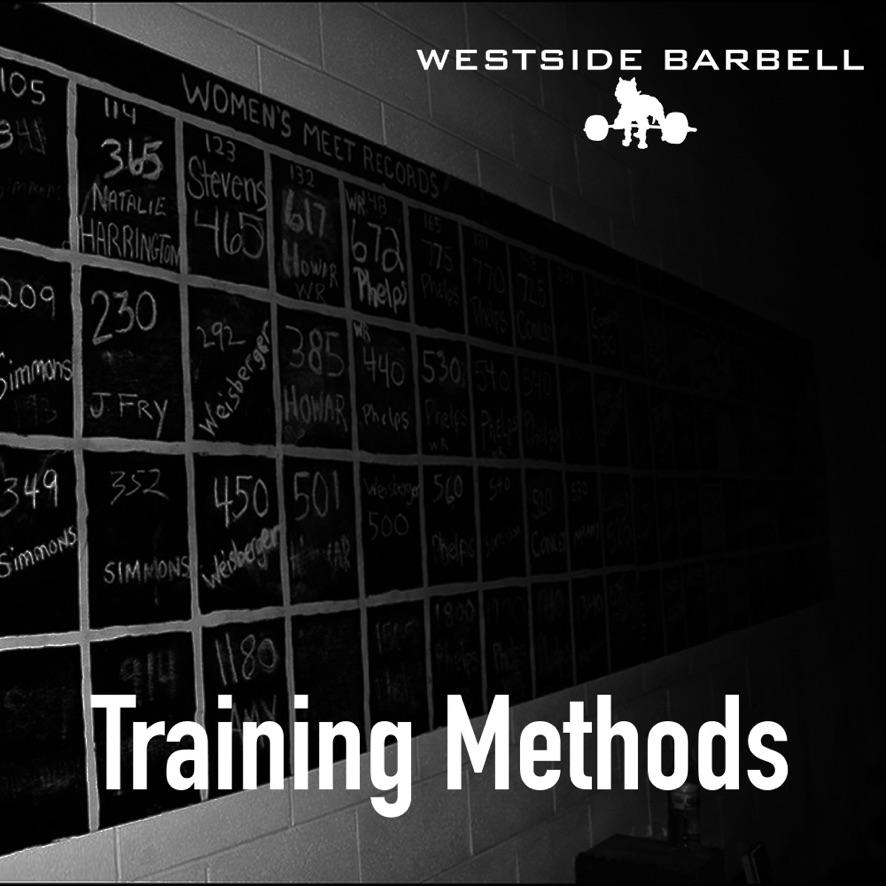Training Methods

This statement is still present in the world of athletics and strength… Why? The answer is simple; a proper understanding of the Westside Methods has not yet been attained by the speaker of these false words.
In Louie’s original work The Westside Barbell Book of Methods page after page of knowledge was made available in a market screaming for “secrets” and inside information. This book was followed up time and time again with more titles, all containing information on how to train properly using the ever evolving Westside Barbell Methods and the Conjugate System… Yet “Westside doesn’t work for me.”
Question, how does this system create world recorder holders, pro athletes, and some of the strongest people in history yet prevent members of the same species from becoming world record holders, pro athletes, and generally stronger???
The Answer: Lack of true understanding of the system, its individual parts, and how to organize training properly. It is our goal with this newest article to establish your understanding of our methods unconditionally from this point forward. This article will serve as your launch pad for both referencing the titles that have inspired Louie Simmons, and decades of training knowledge at Westside Barbell. This will also serve as your home page, of sorts, that will link you up to previously written articles that explain these strengths at length, as well as additional knowledge regarding traiing. Consider this your “Cliff’s Notes” and reference page of special strengths.
Vladimir Zatsiorksy defines strength as the ability to overcome external resistance by muscular effort, and also the ability to generate maximum maximorum external external force.
An additional view of strength, our preferred starting point on this journey of true understanding comes from the brilliant title Super Training by Yuri Verkhoshansky and Mel Siff that states; Strength is defined as the ability of a given muscle or group of muscles to generate muscular force under specific conditions.
Take a moment and really process the portion of that statement that reads “under specific conditions.” Accepting this phrase into your learning is crucial to understand the concept of special strengths,
Before we go into the explanation of special strengths, answer this question if you can.
“Who is stronger? The person that deadlift 700 pounds, or the person that can perform 50 pull ups?
Without knowing more about the hypothetical scenario this question cannot be answered correctly. However, we do know that if the person that deadlifts 700 is compare to the other individual (who may have a 500 pound dead lift) then we know the 700 pound puller has a greater level of maximal strength. On the other side if we look at the 50 rep individual he or she obviously possess a high level of strength endurance. So we would then compare this information against the other person’s level of strength endurance.
The point to take away is that there are many strengths, most of- if not all, are mutually supportive of one another, with success in all strengths being supported by increasing maximal strength. A visual representation of this is displayed in what is familiar to most of us, in the form of the Force Velocity Curve, as seen below. Here each of the types of strengths are organized by the amount of force applied against the duration of the lift, or effort, itself.

Maximal Strength:
At the pinnacle of this curve, but the foundation of our training is Maximal Strength. Maximal strength can be defined as the maximal strength of a muscle or muscle group in a given movement, which equals the highest external resistance an athlete can overcome or hold with full VOLUNTARY mobilization of his or her neuromuscular system.
Maximal strength can also be subcategorized into three categories:
For all intents and purposes a majority of us will view maximal strength in the form of a completed lift such as the squat, bench press, shoulder press, or dead lift. If you would like to research the intricacies of maximal strength research the works of Tidow, Kurz, and Platonov.
Strength Speed:
…not to be confused with strength speed. Strength speed is the ability to move heavy weights as fast as possible. Strength speed should be viewed as a value given to a load that his been lifted.
Explosive Strength:
Explosive strength, or power, is the ability to use the muscles in conjunction with the central nervous system (CNS) to achieve maximum force in minimal time after an intense muscular stretch. At Westside Barbell we primarily use a variety of jumps to develop explosive strengths. To develop a greater understanding of explosive power and plyometrics we recommend reading the works of Yuri Verkhoshansky as well as Explosive Strength Development for Jumping by Louie Simmons.
Speed Strength:
Refers to the rest of dividing the athlete’s maximal strength in a given movement but the time it takes to reach that value, per Tidow, or we can adapt Thomas Kurz simplified definition of spreed strength with is simply the ability to exit maximal force during high speed movements. Ultimately speed strength, as well as explosive power are trained utilizing sub maximal weights that are moved a maximal speed, while always under control.
Speed strength is often trained, at least at Westside Barbell, by using accommodating resistance in the form of bands and chains, both attached from the floor, as well as suspended over head. The percentage of resistance used is typically 25-30% of the lifter’s one rep max in that particular lift being trained. These percentages allow for the lifter to work the full range of the percentages recommended in AS Prilepin’s chart in the same repetition.
Strength Endurance:
Strength endurance can often be overlooked in the world of contesting single repetition lifts, however possessing, at minimum, as baseline of strength endurance will not only aid in GPP, but also will aid in recovery. Strength endurance must be trained by performing many repetitions of special exercises, but is improved simultaneously by increasing maximal strength. Louie has defined strength endurance as the ability to perform a lengthy display of muscular tension with minimal loss of work capacity.
The higher the maximal strength and conditioning of the athlete, the greater level of strength endurance he or she will possess.
Strength Endurance, like maximal strength, can also be divided into two subcategories, in the form of:
Isometric Strength Endurance: Refers to the length of time one can exert force at zero velocity.
Dynamic Strength Endurance: Refers to performing multiple repetitions of a lift or exercise at sub maximal weights. For training compound movements sets of 2-6 repetitions are usually performed. Performing repetitions to failure or near failure is also a means for developing strength endurance. The lifters and athletes at Westside Barbell will perform many special exercises for a wide a variety of reps and sets, based upon a person’s particular need.
There are several other types of special strengths that should be researched as well, outside of the five primary special strengths previously mentioned. In addition to these strengths we not only recommend developing the following strength, but at the very least study them for your own coaching or athletic efforts, as all strengths in one form or another are trained in a complete training program.
The ability to increase muscle tension in a fixed position. For a simple example think of holding weights in a fixed position by pulling or pushing them into position. Isometric strength will not have a direct carry over to maximal strength or speed, however it will aid in the elimination of sticking points. Strength built via isometrics and quasi-isometrics will have a direct relation to the joint angle in which they are trained.
Improving strength at these weaker joint angles will allow for lifts that were once missed due to a lack of strength at the various angles and body positions displayed during a maximal lift. To further reinforce this concept we recommend studying the force posture curve and the laws that are derived from the concepts explained within.
Starting Strength:
Starting Strength is present in not only athletics, but in barbell sports as well. It can be defined as the maximum amount of force that can be generated by a person in the first 30 milliseconds after the start of a muscular contraction.
As mentioned earlier there are many more types of special strength, and we recommend that coaches lear, at the very least, the basics of all types. It is by developing this understating that a coach will better be able identify the particular type of strength that is being utilized by an athlete, and develop an organization of training so that no one area of strength suffers at the expense of another too greatly.
Not to be confused with maximal strength, Absolute strength refers to the true 100% potential of a muscle void of “reserved strength” which is inhibited by the autonomic nervous system. This special strength can not be voluntarily recruited and is void of comparison against body weight. An external stimulation such as electro-stim in contention with a voluntary contraction of that stimulated muscle is one of the few ways to achieve true absolute strength. It is important for a strength coach to understand the true difference in maximal strength which is developed and displayed voluntarily versus absolute strength.
Remember, in the Conjugate System as well as in the Westside Barbell Methods all pertinent strengths are trained simultaneously, rather than in a traditional periodized method.
Each workout within the training week will specialize in one primary special strength, while drawing from each of the other types at various times throughout the training session.
Training Methods and Special Strengths:
Maximal strength is trained on Max Effort Day, utilizing the max effort method. The maximum effort method refers to lifting a weight for a true one rep max for the day. At Westside Barbell two max effort days per week are used, one for the lower body, and one for the upper.
During these training sessions the primary movement of the day is a barbell lift, typically with a variation of a classic lift. After completion the main movement several accessory exercises are performed to address the musculature of the main movement performed. These smaller movements are used to train special strengths and also are “regulated” by a training method as well. The method most commonly used for our accessory work is the repetition method, in which sub maximal weights that typically isolate a muscle or small group of muscles are lifted to failure or near failure. This simultaneously trains the muscle appropriately while also increasing strength endurance in said muscle or group.
Speed strength and explosive power are both trained in the same training week as well. These strengths are trained utilizing the dynamic effort method in which sub maximal weights are lifted at maximal speed.
Again as a training session progresses additional strengths are trained utilizing different methods. We will again move from our main movements on the barbell to special exercises performed at a higher volume on this day, compare to max effort days.
Within the training of accessories training can be organized so that isometrics, plyometrics, and GPP work are performed so that all facets of special strengths are trained.




